No car company learns faster than Hyundai (with the possible exception of its ward, Kia). While some competitors can let engineering flaws drag on for years, any glitches with a new Hyundai tend to be gone well before the second model year begins. Similarly, common criticisms in reviews are often addressed with tweaks in the next model year or two. Hyundai first offered the Sonata midsize sedan as a hybrid for the 2011 model year, significantly tweaked it in response to criticisms just two years later, and has thoroughly revised the car for 2016. I drove a Sonata Hybrid around town for a week then from Detroit to Chicago and back to see how far Hyundai's initial hybrid has progressed.
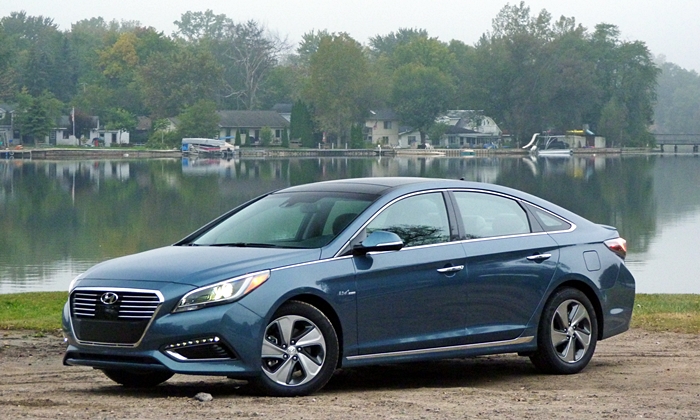
Less striking, more conventional exterior with the 2015 redesign. Is it now boring? more Sonata photos
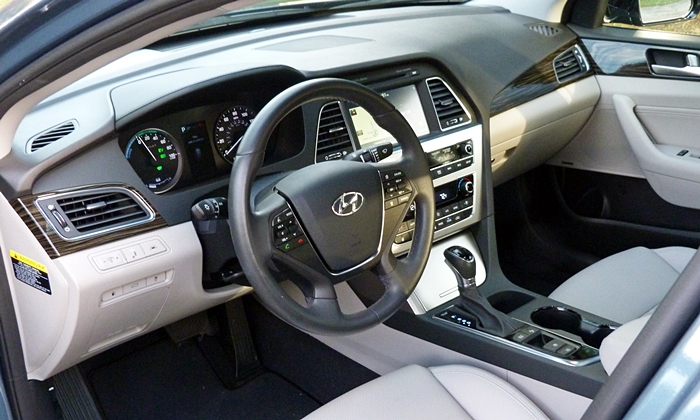
The new, much less curvy instrument panel enhances roominess real and (especially) perceived.
| |
Compared to the Camry |
| Warranty, maintenance cost |
 Better
Worse
Better
Worse
|
The 2016 Hyundai Sonata Hybrid is a much better car than the 2013-2015, much less the 2011-2012. But current competitors are also very good. One thing that continues to separate the Sonata from the pack is a much longer standard warranty, five years / 60,000 miles instead of the typical three years / 36,000 miles. Hyundai's powertrain warranty is even longer, ten years / 100,000 miles--but this applies only to the first owner. The second owner gets 5/60 on the powertrain, which many competitors match.
The original owner also gets a lifetime warranty on the battery pack. Subsequent owners get a less generous--but still better than others--10/100 warranty on the battery pack. All owners enjoy a 10/100 warranty on the hybrid power control unit, starter/generator, traction motor, and transmission. This could be the deciding factor for people concerned about hybrid component repair costs down the road.
| Powertrain performance |
 Better
Worse
Better
Worse
|
The Hyundai Sonata Hybrid isn't the quickest midsize sedan hybrid. That honor goes to the Toyota Camry followed closely by the Honda Accord, both of which have much stronger electric motors than the Hyundai (141 and 166 horsepower, respectively, vs. 51). Compared to those cars, the Sonata Hybrid takes another half-second or so to get from a dead stop to 60 mph--figure eight seconds rather than 7.5.
The hybrid's time is similar to that for the non-hybrid Sonata, since the electric motor compensates for a smaller, less powerful gasoline engine. The previous Sonata Hybrid had a 159-horsepower 2.4-liter engine. The new one has a 154-horsepower 2.0-liter, while the current non-hybrid has a 185-horsepower 2.4-liter. This is comparing full-throttle accleration. In typical around-town driving the hybrid feels stronger than the non-hybrid. The electric motor makes an especially noticeable difference at low rpm, so there's less need to rev the engine for a given amount of power, and acceleration feels smoother and more effortless. If you expect a hybrid to feel slow, you're in for a surprise--with any of the midsize sedans.
Returning the comparison to competing hybrids, the Hyundai Sonata Hybrid's powertrain distinguishes itself more qualitatively than quantitatively. It might not be the quickest, but it is the most pleasant to drive. Unlike in the Toyota, Honda, and Ford, the transmission remains a conventional six-speed automatic, just with electric motor taking the place of a torque converter between the engine and transmission. As a result, while accelerating the Hyundai Sonata Hybrid feels much like a regular Sonata, just with more low-end torque. There's none of the weird slipping disconnect between the speed of the engine and that of the car that mars the driving experience in CVT-based hybrids. The gas engine can shut off and disconnect at speeds up to 75 mph, but unlike in the Toyota, Honda, and Ford tends to automatically restart when even a slight amount of acceleration is requested. The related Hyundai Sonata Plug-in Hybrid, designed to operate on electricity alone for the first 27 miles or so, has a somewhat stronger, 67-horsepower electric motor.
It's possible to select among normal, sport, and eco modes. In sport mode, the throttle responds too eagerly for my taste. To me, the car felt better in normal and even in eco mode.
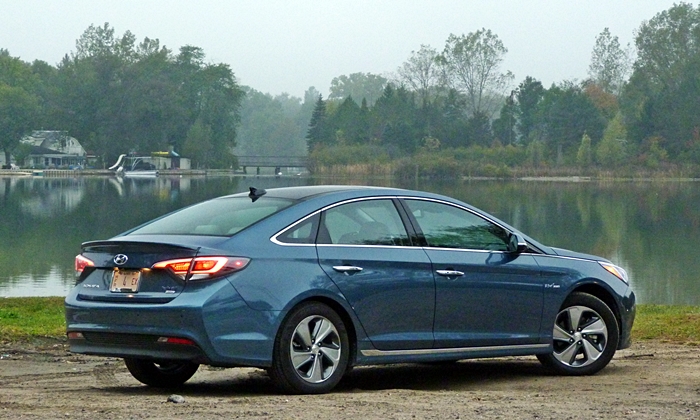
This blue suits it.
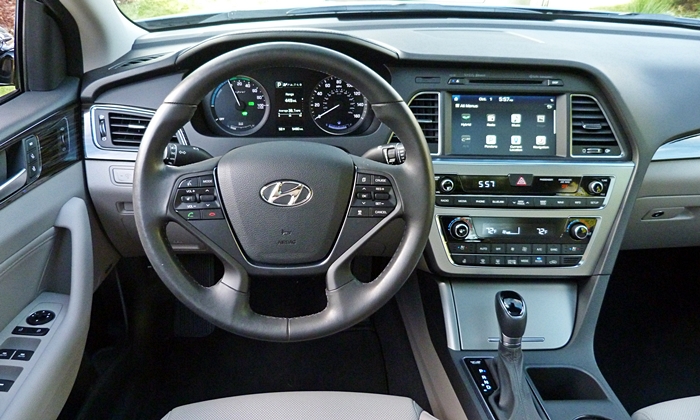
Functional instrument panel, but why did they make it so plain, even cheap-looking?
| Handling |
 Better
Worse
Better
Worse
|
The Hyundai Sonata Hybrid isn't tuned to feel sporty. For a somewhat sporty hybrid midsize sedan, check out the Toyota Camry Hybrid SE. Yet I enjoyed driving the Sonata more than I did the Camry Hybrid SE or the Accord. The Hyundai's steering feels direct and lively (if perhaps a touch light in normal mode) while the chassis feels nimble yet poised. In comparison, the Toyota provides more artificial and less nuanced feedback while the Honda feels about as lively as the Hyundai but somehow less polished and substantial. With the new Sonata, Hyundai has struck a balance between isolation and feedback much better than in the past. Plus, in hard turns the new Sonata Hybrid plows and rolls considerably less than the previous one did, and maintains its composure much better over broken pavement. The Kumho Solus tires even grip reasonbly well, and resist squealing.
While the Sonata Hybrid's ride sometimes feels a touch too firm, there's little in the way of wallow or float. Noise levels are fairly low, even at highway speeds. Overall, the new Hyundai Sonata Hybrid is one of those cars that just feels right. I enjoyed my week with it far more than I expected to.
| Feature availability |
 Better
Worse
Better
Worse
|
If you can get a feature on a competitor, you can likely get it on the new Hyundai Sonata. Available options include a panoramic sunroof, a heated steering wheel, heated-and-cooled front seats, heated rear seats, xenon headlights, full-range adaptive cruise control, forward collision warning, blind spot warning, lane departure warning, and a nav system with both Apple Car Play and Android Auto support.
Inexplicably missing from the list with the hybrid, but not the regular Sonata: automatic braking.
The not-so-good part: none of these features are available as individual options. With the Sonata Hybrid, you must choose from just three configurations: SE ($26,835), Limited ($30,935), or Limited with the Ultimate Package ($35,435). Want a sunroof or adaptive cruise control? Then you must get the fully loaded car. If you simply want the folding rear seat, and not just a small pass-through, you must spring for the Limited.
| Price or payments |
 Better
Worse
Better
Worse
|
Compared to the regular, similarly loaded Hyundai Sonata, the hybrid lists for $2,390 more, $35,435 vs. $33,035. This modest bump was easy to justify when gas cost more than $3 per gallon, but could be more difficult now that gas costs half as much and the EPA projects fuel savings of only about $200 per year.
But the cost of gas has to go up again eventually, right?
The even loftier sticker of the Sonata Plug-In Hybrid would be even harder to justify, except a $4,919 federal tax credit reduces its net price to $919 below that of the regular Hybrid. The Plug-In Hybrid isn't available with a panoramic sunroof, a folding or heatable second-row seat, or second-row sun shades, though. Adjust for these features, and the Sonata Plug-In Hybrid runs about $900 more than the regular Sonata Hybrid when both are loaded up. Comparing base trim to base trim, the Plug-In Hybrid runs $3,681 more before adjusting for its higher level of standard equipment and about $1,400 higher afterwards. Depending on how one feels about the features present on one and not the other at various levels (for some reason there's no way to equip them remotely the same), the Plug-In Hybrid might make more financial sense even at today's gas prices.
The additional oomph in around-town driving justifies some of the hybrid's higher price compared to the non-hybrid. But if you really want quick acceleration, sacrifice more fuel economy and get the Sonata 2.0T, which costs a little less than the hybrid.
And compared to competitors? Load up both a Hyundai Sonata Hybrid Limited and a Toyota Sonata Hybrid XLE, and their stickers end up a mere $30 apart--probably not a coincidence. BUT the Hyundai has nearly $2,700 in additional features that simply are not available on the Toyota. Compare base cars with no options, and the Hyundai is $790 less before adjusting for its additional content, and about $1,300 less afterwards. Note: Toyota dealers enjoy wider margins. Compare invoice prices and the Hyundai's advantage shrinks considerably.
Honda has done so well with the Accord Hybrid that they decided not to offer it for 2016. But you might still be able to find a new 2015. And they're promising an improved hybrid for mid-year as an early 2017. The 2015 Accord Hybrid Touring cost $440 more than the tested Hyundai before adjusting for feature differences, and about $3,600 more afterwards--even fewer features are available on the Honda than on the Toyota. Comparing base hybrid models, the Honda costs a substantial $3,290 more before adjusting for feature differences, and about $3,400 more afterwards.
In sum, the Hyundai Sonata Hybrid costs considerably less than the Toyota and the Honda, especially if you adjust for its additional content.
| |
Compared to the Camry |
| Interior styling |
 Better
Worse
Better
Worse
|
Last year, I listed exterior styling as the #1 why-not for the then-new Hyundai Sonata. Perhaps I was too hard on the car. The new Sonata's exterior remains far less distinctive and far less likely to even be noticed than that of the 2011-2014 Sonata. But especially in the tested blue the 2016 Sonata Hybrid is rather handsome, with no ugly nose grafted on this time around to distinguish it from the non-hybrid. (I'm not a fan of the face of the 2011-2015 Sonata Hybrid.) Also, it remains a more attractive car than the Toyota Camry and the Honda Accord, if not the Ford Fusion.
On the other hand, the Sonata's new interior continues to leave me cold. While the switch from curves to rectilinear forms enhances perceived roominess, it also yields an interior that is almost painfully plain. The contour and finish of the trim plates on the instrument panel and console recall a happily bygone era in Detroit's automotive design history. The Toyota Camry's interior is little if any better, and is arguably a bit of a mess. But this is no excuse. The goodness of the rest of the Sonata warrants more sophisticated and upscale interior styling.
This opens the door wide for Kia, which for 2017 will offer the Hyundai Sonata Hybrid in a much more stylish package. Interested in the non-hybrid? Then you can already buy the updated Kia Optima. (I'll be reviewing the new SX-L soon.)
With this, I'm pretty much out of reasons not to buy a Hyundai Sonata Hybrid.
| |
Compared to the Camry |
| Fuel economy |
 Better
Worse
Better
Worse
|
Why isn't fuel economy among the why-to-buys for the new Sonata Hybrid? Well, while fuel economy is certainly very good, it's not as good as that of the Toyota Camry or Honda Accord. The Ford Fusion Hybrid might also have an edge.
In the EPA's tests, the Hyundai Sonata Hybrid managed 40 mpg city, 44 mpg highway. (The heavier Limited scores one mpg lower in each test.) The Honda Accord Hybrid scored similarly on the highway test (45 mpg), but much higher on the city test (50 mpg). This is largely because the Hyundai has a smaller electric motor and a more conventional transmission, so it cannot take as much advantage of a hybrid system's benefits in stop-and-go driving. For the same reason, the Toyota Camry Hybrid LE, with a powertrain design that is nearly a decade old, did better than the Sonata Hybrid on the city test (43 mpg), but not as well on the highway test (39 mpg). Step up to the Camry Hybrid SE or XLE, and the ratings fall to 40/38, seemingly giving the Hyundai parity in the city and a clear advantage on the highway.
The thing is, in my highway driving the Hyundai Sonata Hybrid's trip computer reported a two-way average of 36.5 mpg, well short of the 44-mpg estimate. I was on a 70-mph Interstate. Driven 55 miles-per-hour the Sonata Hybrid should have much less trouble matching the EPA estimate. But who drives 55 on the highway? I didn't drive the Honda on the highway, but in my highway driving the Toyota Camry SE averaged about 44 and a Lincoln MKZ (related to the Ford Fusion, and with a 41/39 rating) averaged about 47. For some reason the Hyundai's EPA-suggested fuel economy advantage on the highway didn't pan out in my real-world driving.
In my suburban driving the Sonata Hybrid's trip computer usually reported averages in the low 40s and once as high as 50. Very good for such a roomy sedan, but I observed marginally better suburban trip computer figures in the others in typical driving, and they seem to have more upside potential in the hands of a skilled hypermiler. I cracked the 50-mpg mark much more easily in the Toyota and especially the Honda than in the Hyundai.
The new Sonata Plug-In Hybrid shouldn't be quite as quick or as fuel efficient, given the additional weight of its larger battery pack, but can travel about 27 miles on electricity alone.
Don't want a hybrid? The Sonata is offered with three other engines: a 1.6-liter turbo rated 28/38, a 2.4-liter rated 25/38, and a turbocharged 2.0-liter rated 23/32. The EPA ratings suggest that the first two should nearly match the hybrid's fuel economy in highway driving.
| Driving position & visibility |
 Better
Worse
Better
Worse
|
Though the new Sonata's instrument panel is a little tall for my taste, good visibility in all directions boosts driver confidence. Instrument panel ergonomics are good by current standards, with controls that are easy to understand, reach, and operate.
| Front seat support & comfort |
 Better
Worse
Better
Worse
|
The Hyundai Sonata's front seat bottom cushions feel a little flat and hard, but the seat backs proved comfortable even on long drives. The previous car's seats were better contoured and provided more lateral support to those of us with somewhat slender builds. The redesigned Sonata's much less curvy interior styling pays off with much more perceived room in the front seat.
| Rear seat room & comfort |
 Better
Worse
Better
Worse
|
The Hyundai Sonata's real roominess story is in its back seat, where all but the largest adults will find plenty of space. There's about as much rear seat room in the Honda Accord, and nearly as much in the Toyota Camry, but considerably less in the Ford Fusion.
| Cargo capacity |
 Better
Worse
Better
Worse
|
The Sonata Hybrid's redesigned battery pack fits entirely beneath the floor of its trunk. Though the hybrid bits still reduce trunk space by three cubic feet, this leaves 13.3, a few tenths more than the current Camry Hybrid and Accord Hybrid and significantly more than the original Sonata Hybrid (with 10.7 cubic feet).
Need more? In the Limited the rear seat folds in two sections to reveal a usefully large opening. The seat doesn't fold at all in the Accord Hybrid and reveals a briefcase-sized slot in the Camry Hybrid. This is such a clear advantage--if I had a sixth why-to-buy slot, cargo capacity would be in it--that Hyundai should add a folding rear seat to the Hybrid SE, which currently has just a pass-through via the armrest.
Opt for the Sonata Plug-In Hybrid, and the trunk loses 3.4 cubic feet and the folding seat.
The original Hyundai Sonata Hybrid fell short in driveability, handling, and fuel economy. Just five years later, though, the 2016 is the best all-around car in the class. It's not the quickest or most efficient, the Honda Accord Hybrid (on hiatus for 2016) and Toyota Camry Hybrid still achieve better numbers. But the Sonata Hybrid is no longer far off in either area, and subjectively it drives and handles the best. Add in a roomy interior, lengthy feature list, very competitive pricing, and a generous warranty, and the main thing holding the Hyundai Sonata Hybrid back is $1.50 gas.
At the moment, anyway. Later this year Kia will offer a redesigned Optima Hybrid that should be at least as good as the Sonata in every way, but with more attractive styling and a more upscale interior, for about the same price.
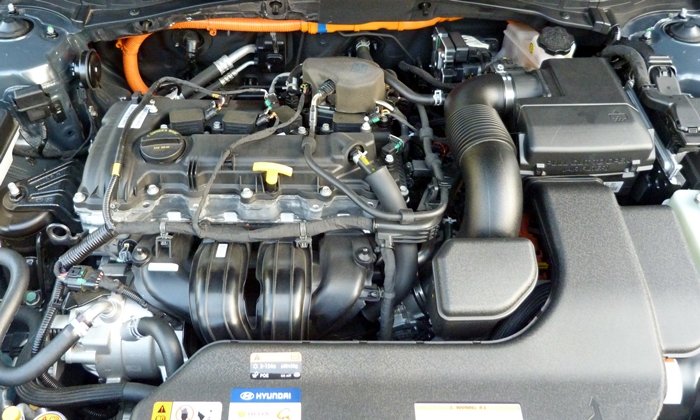
Drives like a regular car. Looks like a regular engine. Only the orange cable reveals its identity.
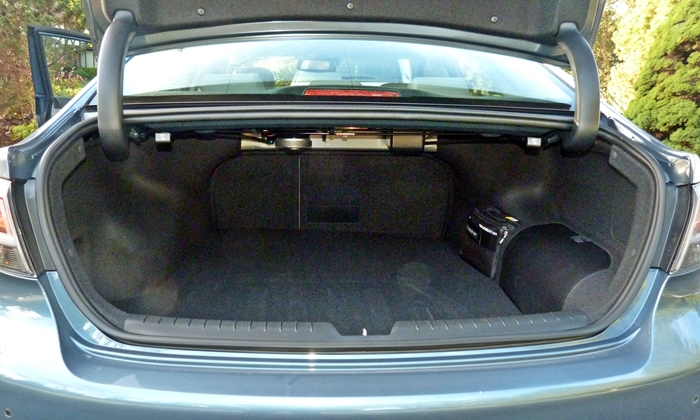
Roomy trunk despite being a hybrid. And the seat folds to open up a uesfully large pass-through.
See more 2016 Hyundai Sonata photos
Hyundai, Toyota, and Honda all provided insured cars for a week with a tank of gas.









